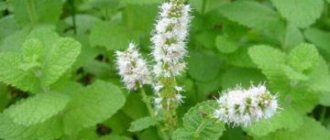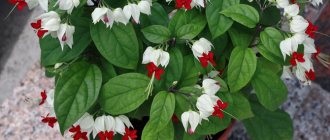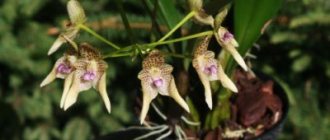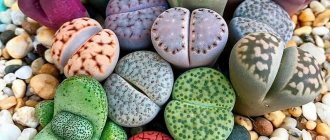Cotoneaster (Cotoneaster) belongs to the rose family, and is represented by deciduous and evergreen slow-growing shrubs or small trees. This plant was named by the Swiss K. Baugin, who was a botanist; he made up the name from two Greek words “cotonea” - “quince” and “aster” - “having a similar appearance.” The plant received this name due to the fact that one type of cotoneaster has leaf blades that are very similar to quince foliage. This genus includes more than 100 species, varieties and varieties. Such plants are found naturally in Eurasia and North Africa. Inexperienced gardeners think that cotoneaster and dogwood are the same plants. And in the end, they plant cotoneaster for the sake of tasty fruits, but they won’t get them from it. These plants are only slightly similar in name, but otherwise they are completely different, and even belong to different families. The fruits of cotoneaster are similar in appearance to a small apple, and they are simply impossible to eat. Dogwood fruits are juicy and tasty. Cotoneaster is valuable because it has a very beautiful appearance, and therefore can become a worthy decoration of any garden.
Features of cotoneaster
Depending on the species, this shrub can be evergreen or deciduous. Most cotoneasters are highly branched shrubs that are often used for street landscaping. In cities you can often find hedges made from such a plant. Small, simple, alternately arranged leaf blades are entire and ovoid in shape. In summer they are dark green in color, and in autumn they change their color to various shades of red. Small flowers are painted white or pink. They can be single or part of inflorescences shaped like a brush or shield. The fruits of the plant are small and have a black or red color. This very slow-growing shrub can be grown in the same place for about 50 years, and in some cases longer. About 40 species of this plant are cultivated, but in addition to them, many varieties and varieties of cotoneaster are also grown. The most popular cotoneasters are: whole-edged, shiny and black-fruited, which are characterized by high frost resistance. Amateur gardeners like this plant because it is undemanding and unpretentious. Professional gardeners often use this shrub to create a hedge.
Features of cotoneaster. Planting and care
Popular questions and answers
We asked agronomist Oleg Ispolatov - he answered the most popular questions from summer residents.
How to choose cotoneaster seedlings?
If you plan to make a hedge from cotoneaster, do not chase large seedlings - they will still have to be heavily pruned. It is important that the plants have a well-developed root system and that there are no signs of diseases or pests on the leaves and shoots.
What to do with cotoneaster in the fall?
In October, you need to carry out moisture-recharging irrigation and mulch the tree trunk circles with peat or compost.
What to do with cotoneaster in winter?
If frost sets in and there is no snow yet, it is advisable to cover ground cover species and varieties with dry leaves. If snow has already fallen, just add a thicker layer to the bushes.
What to do with cotoneaster in spring?
The most important thing is to do sanitary and formative pruning before the buds awaken.
Is it possible to make a hedge from cotoneaster?
Cotoneaster and chokeberry are ideal crops for creating hedges. Trimmed versions of green fencing look especially impressive. They not only zone the garden or protect it from the street and nosy neighbors, but also provide a good background for other ornamental plants.
Are cotoneaster berries edible?
Only cotoneaster aronia has edible berries.
Sources
- Cotoneaster // The Plant List https://www.theplantlist.org/1.1/browse/A/Rosaceae/Cotoneaster/
- Aksenov E., N. Aksenova N. Ornamental gardening for amateurs and professionals. Trees and shrubs // M.: AST-Press, 2001
- Lu Lingdi & Anthony R. Brach. Cotoneaster dammeri // Flora of China https://www.efloras.org/florataxon.aspx?flora_id=2&taxon_id=242315057
- State catalog of pesticides and agrochemicals approved for use on the territory of the Russian Federation as of July 6, 2022 // Ministry of Agriculture of the Russian Federation https://mcx.gov.ru/ministry/departments/departament-rastenievodstva-mekhanizatsii-khimizatsii- i-zashchity-rasteniy/industry-information/info-gosudarstvennaya-usluga-po-gosudarstvennoy-registratsii-pestitsidov-i-agrokhimikatov/
Planting cotoneaster
What time to plant
Almost all types of such plants are recommended to be planted in open soil in the spring. In this case, you need to wait until the earth warms up well, but the buds should not yet begin to open. Also, such a shrub can be planted in autumn, but this must be done after massive leaf fall, but before frost begins. In autumn, for example, it is recommended to plant chokeberry and glossy cotoneaster. Such a plant can be safely grown in shaded areas, and it will look quite impressive. But if the shrub is planted in an open, well-lit area, it will be able to reach the peak of its decorative potential. The quality of soil for cotoneaster is not particularly important. Experienced gardeners advise pouring a suitable soil mixture directly into the planting hole.
How to plant
The size of the planting hole for this plant should be 50x50x50 centimeters. A drainage layer 20 centimeters high should be laid at the bottom, and for this it is recommended to use broken bricks or gravel. On top of it you need to fill it with an earth mixture consisting of sand, peat, humus and turf soil, which must be taken in a ratio of 1: 1: 1: 2. If possible, it is recommended to add 200 to 300 grams of lime into the resulting soil mixture. When choosing a place for planting, you should take into account that there should be a distance of 0.5 to 2 meters from the cotoneaster to a neighboring tree, shrub or building. The final distance in this case depends on the expected size of the crown of an adult shrub. When planting a seedling, you should pay attention to the fact that its root collar should be flush with the ground surface. When planting is completed, the soil must be well compacted and the plant watered. When the water is absorbed into the soil, the surface of the tree trunk circle is covered with an eight-centimeter layer of mulch (peat). If a hedge is created from brilliant cotoneaster, then it is recommended to make trenches instead of holes for planting.
cotoneaster planting
Transplantation after purchase into open ground
Red viburnum is a shrub or tree - description
It is recommended to plant a purchased seedling (at least 2 years old) no later than the end of September. The area should be shady. The soil is suitable with neutral acidity or slightly acidic. Wetlands are not suitable.
Important! A single bush will not bear fruit. You need to plant at least 2 plants.
A hole for planting is dug 0.8 x 0.8 m in size. The soil mixture is enriched with humus and minerals. The root collar should remain on the surface of the earth. After planting, the bush is watered and mulched.
Cotoneaster care
There is nothing complicated about planting and growing cotoneaster. At the same time, difficult situations when growing this shrub arise extremely rarely, and they can be easily resolved. The most important thing that every gardener needs to know is that such a plant reacts extremely negatively to stagnation of liquid in the root system. Other unfavorable natural phenomena cause him virtually no harm. This plant does not need watering at all, even during a long dry and hot period. If there is no rain throughout the entire summer period, then you will still have to water the cotoneaster, and this should be done once every half month, while 1 adult bush requires from 70 to 80 liters of water. After the rain has passed or watering has been carried out, you need to weed the bush and loosen the surface of the soil underneath it to a depth of 10 to 15 centimeters. It should be remembered that the leaves of the bush must be systematically washed with a stream of water, especially if such a hedge of brilliant cotoneaster is used instead of a fence that faces a busy street.
Top dressing
After the first warm spring days arrive, you will need to fertilize the bushes with nitrogen-containing fertilizers. To do this, you can use a urea solution (25 grams of substance per 10 liters of water) or Kemira-universal prolonged-action granules. Before flowering, plants must be fed with superphosphate (60 g per 1 m2) and potassium (15 g per 1 m2). When the season ends, the surface of the tree trunk circle will need to be covered with a layer of mulch (peat).
Pruning cotoneaster
This plant has an extremely positive attitude towards pruning. Experienced gardeners and designers create a variety of shapes from bushes, for example, prisms, cones, hemispheres, etc. It should be remembered that the annual stem can be cut off by only 1/3 of the growth. For curly pruning of cotoneaster, you will need not only special tools, but also certain experience and knowledge. The shoots that grow back after pruning are capable of maintaining their given shape. Such shrubs are also pruned for sanitary purposes; in this case, it is necessary to cut off those branches that are injured, old, affected by disease, or that contribute to thickening of the crown. Over the years, there is a need for anti-aging pruning. A sanitary haircut can be done in any month. In this case, pruning in order to form the crown or rejuvenate the bush should be carried out in early spring, while the buds have not yet begun to open.
Diseases and pests
This plant is highly resistant to diseases and pests. However, quite rarely, apple aphids can settle on the lower surface of the leaves. In infected specimens, the leaf blades become wrinkled, and the stems also become bent and dry out. Scale insects or mites can also settle on the cotoneaster. To get rid of such pests, you can use decoctions made from tobacco, shag or yarrow. You can also use more powerful insecticides. Cotoneaster suffers from fusarium blight more often than other diseases. To cure a shrub, you need to cut out the affected parts of the plant to healthy tissue, and then treat it with a fungicidal agent.
Pests
Cotoneaster is famous for the fact that it is practically not afraid of pests and diseases. Sometimes you can see apple aphids on the shoots, which have a detrimental effect on the development of the bush, causing significant damage to it. As a result, the branches and leaves dry out, so pests must be dealt with in a timely manner. These also include plum sawfly, scale insects and cotoneaster mites.
Cotoneaster propagation
Different types of such plants can be propagated in different ways. Those who want to grow this shrub from seeds should take into account that its seeds have extremely low germination rate; therefore, they should be sown with a reserve. Sowing is done directly into open ground before winter. Before the onset of spring, the seeds will be able to undergo natural stratification in the soil. Seedlings should appear with the onset of spring. This plant can also be propagated by cuttings, dividing the bush and layering.
How to grow from seeds
First, you need to collect the fruits of the plant and wait until they fall down a little, in which case the pulp can be quite easily separated from the stone. The extracted seeds should be washed thoroughly in clean water. They are then placed in a glass jar filled with water. Those seeds that remain floating on the surface can be safely thrown away. For sowing, you should use those that have sunk to the bottom of the container. Then the seeds must be combined with peat and sand, and the resulting mixture placed in boxes. Next, the boxes are put away for storage until the onset of spring in a place where the air temperature will remain around 0 degrees. In this way, the seeds will be able to undergo stratification, and in the spring they will need to be planted in open soil. But it is worth considering that even correctly carried out stratification is not a guarantee that the seeds will sprout.
Cuttings
When the cotoneaster bush is pruned, there will be many cuttings left that can be rooted. However, the most suitable time for cutting cuttings is June. Sections of prepared cuttings should be immersed for 24 hours in a container filled with a solution of a product that stimulates root formation. Then they should be planted on a previously prepared bed at an angle of 45 degrees. The soil should be loose and light, and consist of peat and sand. Then you should water the cuttings with lukewarm water and cover them with a large plastic bottle, the neck of which should first be cut off. On a hot day, the cotoneaster may begin to rot, and to prevent this from happening, the shelter should be removed for the day. Watering can be done without removing the shelter. By the onset of the next spring, the cuttings will have formed roots and can be planted in a permanent place.
How to propagate by layering
This method of propagation is often used for ground cover species, for example, horizontal or creeping cotoneaster. In these species, the stems are in close proximity to the ground surface or touch it. Select young stems and secure them to the soil surface with a hook or metal staple. Then the attachment point must be sprinkled using humus. With the onset of the next spring, the rooted cuttings can be separated from the parent bush and transplanted to a permanent place. This method of reproduction is the simplest and most effective.
How to propagate by dividing a bush
It is quite possible to divide adult, heavily grown bushes into several parts. The resulting cuttings can be rooted. This method is distinguished by its speed and high efficiency. The bush can be divided in spring or autumn, and the divisions must be immediately planted in a permanent place.
Diseases
He gets sick extremely rarely. Fungal infection is possible in conditions of high humidity and unfavorable weather. Particularly susceptible to fusarium. They begin to combat this by using Bordeaux mixture; spraying is carried out in spring and autumn.
If it doesn’t help, try replanting the plant in a new place, cutting it short before doing so. The old planting site needs to be dug up and disinfected with copper sulfate. Excellent prevention is drainage and systematic loosening of the soil at the planting site.
Pests love the bush more than fungi. These can be a variety of mites, aphids, and scale insects. If the scale of the disaster has not become enormous, you can try traditional methods. Recommended decoctions:
- yarrow;
- tobacco dust;
- soap solution with ash.
For severe forms of damage and a large number of pests, insecticides are used. Since cotoneaster is not edible, processing can be done at any time. Aphids are eliminated by long and thorough spraying.
One-time procedures will not give any effect. Karbofos and Nitrofen will help not only against this scourge, but also against caterpillar larvae. An infusion of shag and potato tops is less effective in strength, but will have its effect at the initial stage.
Aktara and Aktellik work for sure. It is important to take precautions when handling chemicals - wear a mask and protective gloves.
Cotoneaster in winter
Autumn
Almost all types of cotoneaster are distinguished by their frost resistance and can easily survive the winter without insulation. However, the tree trunk circle must be sprinkled with a layer of mulch (peat). If there is a threat of freezing of the cotoneaster, it is recommended to bend it to the soil surface and fix it in this position. Then the bush must be covered with dried leaves.
Wintering
If little snow or too frosty winter is expected, then the bush can be additionally insulated with covering material or spruce branches. If a large amount of snow falls, it is recommended to remove the shelter. The bushes will need to be covered with a layer of snow. In the middle zone, the most popular cotoneasters are whole-edged, black-fruited and shiny. These species are characterized by very high winter hardiness and can withstand severe frosts without insulation.
Types and varieties of cotoneaster with photos and names
Below we will describe the types of cotoneaster that are most popular among gardeners.
Cotoneaster lucidus
His homeland is Eastern Siberia. This shrub can grow in nature both in groups and individually. This deciduous shrub has dense foliage and is an upright grower. This plant can reach a height of 200 centimeters. On the surface of young shoots there is dense pubescence. The length of the dark green glossy leaf plates is about 5 centimeters, while they have an elliptical shape and are pointed towards the tip. Loose inflorescences in the shape of a shield consist of pink flowers. Flowering begins in May or June and lasts 4 weeks. After flowering, glossy black spherical fruits appear, which do not fall until the onset of winter. The bush begins to bear fruit at the age of four. This type is used to create a hedge or decorate the lawn and edge. Cultivated since the beginning of the 19th century.
Cotoneaster melanocarpus
Suitable for growing in mid-latitudes, as it has sufficient winter hardiness. The fruits of this cotoneaster, unlike many other species, can be eaten. Under natural conditions, this shrub is found in Central Asia, Central Europe, the Caucasus and Northern China. The height of the bush can reach 200 centimeters. Black fruits are located on brown-red stems. The length of the ovoid leaf plates is about 4.5 centimeters, while the front side is dark green and the back side is white felt. The apex of the leaflets is obtuse or notched. The plant begins to bear fruit every year from the age of five. Loose racemose inflorescences consist of 5–12 pink flowers. Flowering lasts approximately 25 days. This species is frost and drought resistant. This excellent honey plant also has wood from which pipes, canes, etc. are made. There is a decorative form of laxiflora. It is distinguished by loose, drooping inflorescences and larger fruits compared to the original species. Cultivated since 1829
Cotoneaster integerrimus
This deciduous shrub can be found in natural conditions from the North Caucasus to the Baltic states on mountain slopes, in sandstones and limestones. This plant is rarely cultivated. The bush can reach 200 centimeters in height. It has a rounded crown. The surface of young branched stems has woolly pubescence. However, over time they become bare. The length of the broadly ovate leaf blades is about 5 centimeters. The front side is smooth, glossy, dark green, and the back side is gray-felt. The racemose inflorescences consist of 2–4 whitish-pink flowers. The diameter of the rich red fruits is approximately 10 mm. This plant is highly resistant to frost, drought and gas. Cultivated since 1656
Cotoneaster horizontalis
This shrub is related to the prostrate species. The height of such an evergreen plant is about 100 centimeters, while its crown can reach 150–200 centimeters in width. The stems are arranged in layers, like the backbone of a fish. Glossy green leaf blades, which have a rounded shape, change their color to fiery red in autumn. Small whitish-pink flowers open in the last days of May. Flowering lasts approximately 20 days. A lot of scarlet fruits appear on the bush, which are fully ripened in September. In some cases they do not fall until the following spring. This species places special demands on the quality and composition of the soil. Cultivated since 1880. There are a couple of varieties:
- Variegatus. It reaches a height of 0.3 m, with a crown diameter of about 150 centimeters. The leaf blades have a white stripe along the edge.
- Perpusillis. The height of the prostrate bush reaches 0.2 meters, while its diameter can reach 1 meter. Slow growing. Pink flowers bloom at the beginning of summer. The scarlet-colored fruits ripen in the last days of summer. In autumn, green leaf blades change their color to burgundy.
Dammer's cotoneaster (Cotoneaster dammeri)
This shrub is very similar in appearance to horizontal cotoneaster. In natural conditions it can be found in the mountains of Central China. Creeping stems practically come into contact with the surface of the soil, and therefore they often take root on their own. The stems branch in one plane, and they rise no more than 20–30 centimeters. At the same time, they can grow up to 150 centimeters in width. The small leathery leaf blades are elliptical in shape. In summer they are dark green, and in autumn they are purple. Sessile flowers are colored light red. The red-coral berries ripen in September, and they stay on the bush for a long time. Cultivated since 1900. Popular varieties:
- Eichols. It reaches a height of 0.6 m and has orange-red berries.
- Coral Beauty. The height of the bush is about 0.4 m. Large single berries are colored red. This plant is distinguished by the greatest frost resistance of all varieties that are available in this species.
- Stockholm. The height of the bush is about 100 centimeters. The color of the berries is rich red.
Cotoneaster adpressus
This shrub is a dwarf creeper. It reaches a height of about 50 centimeters, and its diameter is approximately 100 centimeters. The stems are pressed to the surface of the soil. Small leaf blades have a rounded shape. In summer they are pale green, and in autumn they are rich or dark red. In the last days of spring, a large number of pink flowers open. Such a plant must be covered for wintering.
Gardeners also grow cotoneasters: splayed, moupinsky, holly, small-leaved, multi-flowered, pink, single-flowered, Henry, vesicular, Franchet, racemosa.











